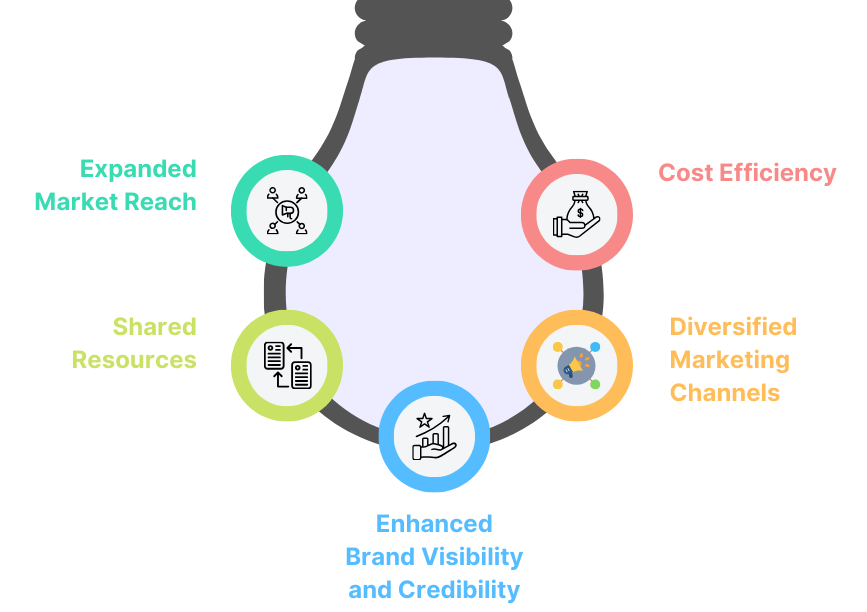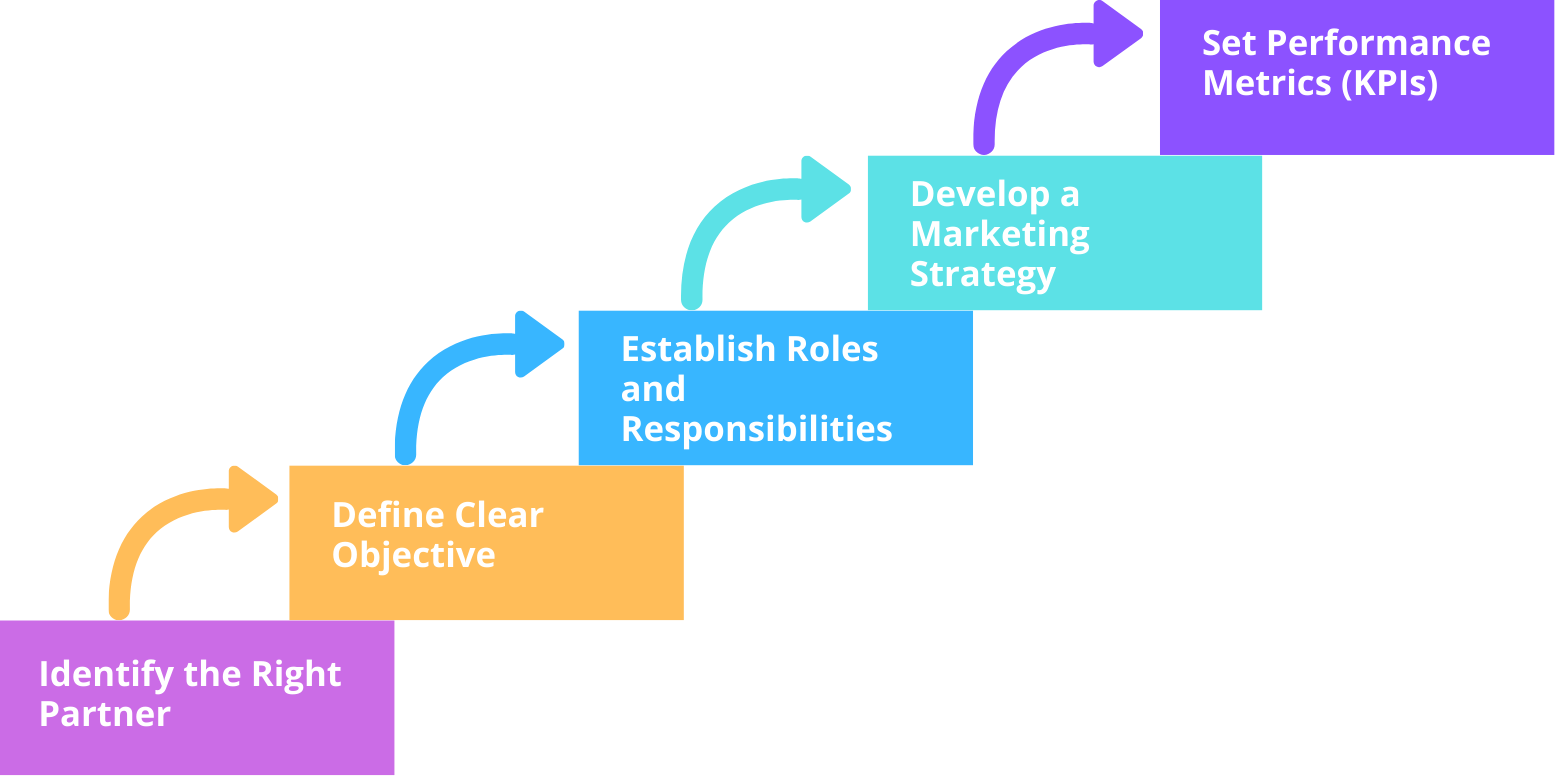Joint marketing agreements (JMAs) are strategic partnerships between two or more companies, where they collaborate to promote products or services. This collaboration allows businesses to tap into new markets, leverage shared resources, and increase brand visibility. By combining efforts, companies can achieve a greater reach and enhance their competitive advantage.
In this blog, we will explore the key components of JMAs, the benefits they offer, key considerations when drafting such agreements, and how they can foster long-term business growth and collaboration.
What is a joint marketing agreement?
A joint marketing agreement is a formal contract where two or more businesses agree to pool their marketing efforts for mutual benefit. The scope can vary from joint advertising campaigns to co-hosting events, content co-creation, and sharing customer data for targeted marketing. The goal is to combine efforts in ways that enhance the strengths of both (or all) parties.
Key Components of a Joint Marketing Agreement

1. Scope and Purpose:
Clearly outline the marketing activities and the scope of the agreement. This section should define the goals, target audience, and metrics of success for the partnership. Are both companies promoting the same product? Or are they cross-promoting related services?
2. Roles and Responsibilities:
Define the specific roles of each party in the joint venture. Who is responsible for content creation? Who will handle distribution and monitoring? This subsection ensures accountability and helps avoid confusion during the campaign.
3. Financial Obligations:
Both parties must agree on how the costs will be shared, whether it’s a 50/50 split, or based on each partner’s level of involvement. Be sure to include details about who pays for marketing materials, advertisements, or third-party services.
4. Marketing Materials and Branding Guidelines:
Ensure consistency in branding by setting specific guidelines for the use of logos, taglines, and visual elements. This is especially crucial to protect the brand identity of each party and maintain the overall quality of the marketing materials.
5. Confidentiality and Data Sharing:
If both parties share proprietary information, customer data, or marketing insights, it’s essential to outline how this information will be used, stored, and protected. A confidentiality clause ensures that sensitive data remains secure.
You might want to read: What is Lack of Notice in Contracts?
Common Challenges join marketing agreement
While joint marketing agreements offer numerous advantages, they are not without their challenges. Miscommunication, misaligned goals, and resource imbalances can all hinder the success of the partnership. In this section, we will dive into common obstacles businesses face when entering a joint marketing agreement and provide practical strategies to overcome them.

1. Misaligned Goals
The Challenge:
One of the most common issues with joint marketing agreements is when partners have different or misaligned objectives. For example, one company may be focused on brand awareness, while the other is looking for direct sales. This divergence can lead to ineffective campaigns that don’t meet the needs of both parties.
How to Overcome It:
Before signing the agreement, have in-depth discussions about each partner’s goals and what they hope to achieve through the partnership. Ensure that both parties have complementary objectives, and document these in the contract. Regularly revisit these goals throughout the collaboration to ensure alignment and adjust the strategy if necessary.
2. Resource Imbalance
The Challenge:
If one party contributes significantly more resources—whether it’s financial, creative, or time investment—it can create resentment and an unequal partnership. This imbalance can also result in one company shouldering the burden of responsibility for the campaign’s success.
How to Overcome It:
Clearly outline each party’s responsibilities and contributions in the agreement. The distribution of resources should be as equitable as possible, and if one party provides more funding, it should be compensated with other benefits, such as a larger share of profits or more prominent branding. Regular reviews can help ensure that the workload and investments remain balanced.
3. Communication Gaps
The Challenge:
Joint marketing agreements often involve teams from different companies, and miscommunication can easily occur. Lack of regular updates, unclear instructions, or differing expectations can lead to delays, misunderstandings, and ultimately, failed campaigns.
How to Overcome It:
Establish a clear communication plan from the outset. Schedule regular meetings, set up shared project management tools, and appoint point persons from both sides to facilitate smoother communication. Ensure that any updates, milestones, or issues are promptly addressed, so that both teams stay informed and aligned.
4. Conflicting Branding and Messaging
The Challenge:
Each company in a joint marketing agreement has its own brand identity, tone, and messaging. When these conflict, the marketing material can become disjointed, confusing the audience and diluting the effectiveness of the campaign.
How to Overcome It:
Develop a branding guideline that harmonizes the elements of each brand. This can include shared messaging, complementary design elements, and an agreed-upon tone of voice. Additionally, have a review process where both parties approve all marketing materials before they go live, ensuring consistency and brand alignment.
5. Unequal Return on Investment (ROI)
The Challenge:
One partner might benefit more from the joint marketing efforts than the other, leading to dissatisfaction and potential conflict. For example, if one company experiences a significant boost in sales while the other only sees modest gains, the partnership can feel lopsided.
How to Overcome It:
Establish clear KPIs (key performance indicators) from the beginning, and define what constitutes success for both parties. If possible, structure the agreement so that both partners benefit equitably, even if the returns aren’t identical. In cases where one party gains more, adjustments to future agreements or compensation could help maintain a balanced partnership.
You might want to read: Top 7 Contract Management KPIs for Success
Benefits of a Joint Marketing Agreement
Joint marketing agreements (JMAs) can provide a wide range of benefits for businesses, enabling them to collaborate, share resources, and leverage each other’s strengths to achieve mutual goals. Here, we explore the key advantages of entering into a JMA and how such partnerships can accelerate growth, reduce costs, and enhance visibility.

1. Expanded Market Reach
One of the biggest advantages of a joint marketing agreement is the ability to access a broader audience. When two companies collaborate, they can introduce each other’s products or services to their existing customer bases. This opens up opportunities to reach new demographics and geographic areas that may have been difficult or expensive to access on your own.
For example, a regional business could partner with a national company to expand its footprint beyond its current market, helping both brands grow their consumer base.
2. Shared Resources
By combining resources, both parties can reduce costs and share the workload. This could include anything from splitting the marketing budget to pooling creative assets or sharing manpower for campaign execution. As a result, each company is able to achieve more than they would on their own, while reducing the financial burden of marketing activities.
For instance, if two businesses co-sponsor an event, they could share the cost of venue rental, promotion, and staffing. This creates a more cost-effective way to execute large-scale campaigns.
3. Enhanced Brand Visibility and Credibility
A partnership between two businesses often brings enhanced brand visibility. By associating with another reputable brand, both companies can boost their public image and increase trust among consumers. When customers see brands collaborating, it often adds credibility to the products or services being promoted, as it demonstrates that the businesses value each other.
Additionally, joint marketing campaigns that highlight both brands can increase the likelihood of consumers engaging with the content, leading to better brand recall and higher conversion rates.
4. Diversified Marketing Channels
Joint marketing agreements allow businesses to diversify their marketing channels. Partners may have different marketing strengths, whether it be digital advertising, social media, influencer marketing, or traditional advertising. By leveraging each other’s expertise, companies can create more comprehensive and multi-faceted campaigns.
For example, if one company excels in social media marketing and the other has a strong email marketing strategy, they can combine these approaches to maximize their marketing reach.
5. Cost Efficiency
Marketing can be expensive, especially when attempting to break into new markets or launching large campaigns. Joint marketing agreements help reduce costs by allowing partners to share expenses. This cost-sharing applies to everything from advertising space, production costs, and content creation to event hosting and sponsorships.
Moreover, by pooling marketing budgets, companies can afford to engage in larger campaigns that yield a higher return on investment (ROI) than they would on individual campaigns.
You might want to read: Contingent Contracts: An Effective Guide
Preparing for a Joint Marketing Agreement

Before starting a joint marketing agreement, you need to plan carefully. First, find possible partners and check if you all fit well together. It’s important to clearly outline what you want to achieve with the collaboration. If you address these points early on, it can help avoid confusion later and make the partnership smoother and more successful.
Also, it’s important to work together and think about how both sides can benefit. Each party should be open to sharing their skills, resources, and ideas. This teamwork can lead to a strong marketing campaign that gets great results.
Identifying Potential Partners
Finding the right partner for a marketing agreement is very important for success. Start by looking for businesses that go well with what you offer, but do not compete with you directly. These could be affiliates or companies in your industry that attract the same customers or have a strong presence in a market you want to enter.
When you choose potential partners, think about their brand reputation, how well they connect with your target audience, and their marketing skills. It is important to check their past performance, financial health, and ethical standards. This helps reduce risks and makes sure both sides benefit from the partnership. Also, look into what marketing initiatives they already have and their overall marketing strategies.
Seek partners who have a team-oriented attitude and are open to sharing ideas and resources. Good communication and a common goal are key to a successful joint marketing agreement. This will create a more productive and lasting partnership.
Assessing Compatibility and Goals Alignment
Once you find possible partners, it’s important to check if you can work well together and have similar goals. This means you need to know each other’s business aims, who your customers are, and how you market your products. This will help you decide if you can create a good team.
You should also see if the planned marketing activities fit with each partner’s overall marketing strategy and brand image. It’s very important to make sure that working together is smart for both sides. The partnership shouldn’t cause any problems or mix up the brand message.
Have honest talks about what you want to achieve from the marketing agreement. Make clear and measurable goals that are good for everyone. This way, everyone knows what to expect and can work together towards the same plans in accordance with what you agreed on.
You might want to read: Difference Between Unilateral and Bilateral Contracts
Defining the Scope and Objectives

A good marketing agreement starts with a clear scope and specific objectives. This part describes the marketing activities that will be done. It also includes the target audience, area of focus, and how long the agreement will last. By clearly defining these points, everyone can work toward the same goal.
Identify the objectives that both sides want to reach through the joint marketing agreement. These may include raising brand awareness, generating leads, increasing website traffic, boosting sales, or any other measurable results that matter for the partnership. It is important to set realistic and achievable objectives at the start. This helps to track how well things are going and see the success of the joint marketing efforts.
Having a clear scope and objectives gives a structure for planning the marketing strategy and using resources well. It makes sure that the joint marketing actions match the overall business aims of both sides and help in reaching shared goals.
Setting Clear Roles and Responsibilities
Clearly defining the roles and responsibilities of each party is very important in any marketing agreement. You need to outline who is in charge of certain marketing tasks, like creating content, advertising, managing social media, and generating leads. When you assign specific tasks, you cover all parts of the marketing campaign. This helps avoid doing the same work twice.
You also need to state the financial obligations of each party. This means explaining how marketing costs will be shared, any revenue-sharing deals, and how payments and invoices will work. Being open about money matters is important to build trust. It helps prevent any misunderstandings or conflicts over costs.
It’s necessary to include clear clauses in the agreement. These should cover issues like intellectual property rights, confidentiality, and how to end the agreement if needed. This way, both parties’ interests are protected. Make sure to specify who owns the rights to marketing materials created during the collaboration. Also, explain how confidential information will be managed.
You might want to read: What are Fixed Price Contracts?
Step-by-Step Guide to Formulating a Joint Marketing Agreement
Creating a good joint marketing agreement is key to a successful partnership. You can do this by following a clear step-by-step plan. First, set shared goals. Next, write the agreement, talk about the terms, and then finish the document. This helps make sure that all important details are included. It also helps protect everyone’s interests.

Always keep in mind that clear communication, honesty, and teamwork are important while you create and use the joint marketing agreement. A well-made agreement that benefits everyone can lead to a successful and profitable relationship.
- Identify the Right Partner: Choose a partner whose goals, target audience, and values align with yours. Look for complementary businesses to enhance strengths and credibility.
- Define Clear Objective: Establish shared, specific, measurable, attainable, relevant, and time-bound (SMART) goals for the collaboration, such as increasing brand awareness or generating leads.
- Establish Roles and Responsibilities: Clearly outline each partner’s roles, including who handles content creation, budget management, and performance tracking. This ensures accountability and smooth execution.
- Develop a Marketing Strategy: Collaborate to create a cohesive marketing plan that includes target audiences, tactics, timelines, and key deliverables to guide the campaign’s execution.
- Set Performance Metrics (KPIs): Agree on measurable indicators to evaluate the campaign’s success. These might include sales conversions, lead generation, or website traffic, helping both partners assess effectiveness.
This streamlined approach ensures that essential components of the agreement are covered while maintaining clarity and focus.
When do I need a joint marketing agreement
A joint marketing agreement is important when two or more businesses work together on marketing. This is to help promote each other’s products or services. Whether they are co-branding, doing cross-promotions, or running joint advertising campaigns, having a written agreement is key. It explains the terms of the partnership and protects everyone’s interests.
This legal document makes sure that all expectations, responsibilities, and financial duties are clear. This can help reduce the chances of arguments or confusion during the partnership. A joint marketing agreement also protects intellectual property rights, gives rules for keeping things private, and sets up a way to solve problems. This creates a safer and better partnership for everyone involved.
Limitations of a joint marketing agreement
While joint marketing agreements have many benefits, there can also be some limitations. When you team up with another business, you must share control. This shared control can cause disagreements about marketing strategies or creative ideas.
- Lack of Control: Each party may have limited control over the other’s marketing activities, which could result in inconsistent messaging or misalignment with brand values.
- Legal Risks: If the agreement does not adequately address applicable laws, warranties, or remedies, either party could face legal liabilities or disputes.
- Shared Resources: Sharing marketing budgets or resources may lead to disagreements on the allocation of funds or efforts, potentially straining the partnership.
- Brand Reputation: If one party experiences negative publicity or fails to deliver, it can harm the other’s brand reputation due to their association in the joint campaign.
- Performance Imbalance: If one party underperforms or does not meet their obligations, the overall effectiveness of the marketing campaign may suffer, leading to unequal benefits.
Conclusion:
Joint marketing offers numerous benefits, including cost savings through shared marketing efforts and access to new customer bases, enhancing brand visibility. However, to ensure success, it is essential that the agreement is reviewed by legal counsel to confirm compliance with applicable laws. Clear terms regarding warranties and remedies should be established to protect both parties in case of any disputes. When these legal elements are properly addressed and there is strategic alignment, such partnerships can lead to positive outcomes and accelerated business growth.
FAQs
What Are the Key Advantages of Joint Marketing Agreements?
Joint marketing has many benefits. It can save money by sharing marketing efforts. It also gives access to new customers and improves brand visibility. When the terms of the agreement are clear and there is good strategic alignment, these partnerships can help both sides. This can lead to good results and faster business growth.
What warranties are usually included in a joint marketing agreement?
Warranties in a joint marketing agreement may include assurances that the marketing materials are free from any legal violations, such as intellectual property infringement, and that each party has the necessary rights to use the materials.
What remedies are available if one party breaches the agreement?
If one party fails to meet their obligations under the joint marketing agreement, remedies can include financial compensation, termination of the agreement, or other actions agreed upon in the contract, such as mediation or arbitration.
How do we handle intellectual property rights in a joint marketing agreement?
The agreement should clearly state how each party’s intellectual property will be used and protected. It may also specify whether any new intellectual property created during the joint marketing effort will be owned jointly or by a specific party.





